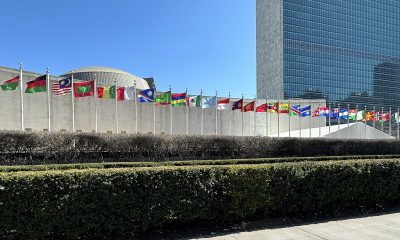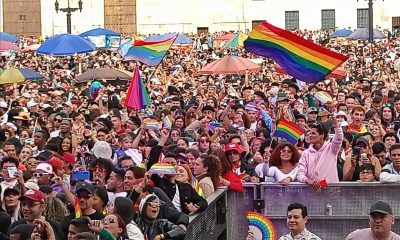Books
A travel memoir with a queer, Black sensibility
Nonbinary author Shayla Lawson is the Joan Didion of our time

‘How to Live Free in a Dangerous World: A Decolonial Memoir’
By Shayla Lawson
c.2024, Tiny Reparations Books
$29/320 pages
Joan Didion, one of the greatest writers and journalists of the 20th century and 2000s, wrote superbly crafted essays – telling engaging stories about the places she traveled to. Reading her, you sensed Didion reacting personally to her travels, and, as a writer, clocking it. To write in stories for her readers.
Shayla Lawson, a nonbinary, Black, disabled poet and journalist, is the Joan Didion of our time.
Their new work, “How to Live Free in a Dangerous World: A Decolonial Memoir,” is a provocative, impeccably crafted, hard-to-put down, travel memoir in essays. (Lawson uses they/them pronouns.)

Lawson is author of “This is Major,” which was a finalist for the National Book Critics’ Circle and the LAMBDA Literary Award, and the author of two poetry collections, “A Special Education in Human Being” and “I Think I’m Ready to See Frank Ocean.” They have written for New York Magazine, Salon, ESPN and Paper, and earned fellowships from the Yaddo and the MacDowell Artist Colony.
Yet, despite this impressive track record, Lawson, who grew up in Kentucky, and has lived and traveled everywhere from the Netherlands to Brazil to Los Angeles to Kyoto, Japan to Mexico to Shanghai, had to wait nine years before a publisher would wrap their head around releasing a travel memoir in essays.
Thankfully, Lawson had the chutzpah to persist in seeking a home for her memoir. Kudos to Tiny Reparations Books for valuing Lawson’s writing and publishing ‘How to Live Free in a Dangerous World.”
From the get-go of their memoir, Lawson draws us in. We’re with them on the plane. Right away, we’re with Lawson – a writer who’s clocking it – telling their story – while they’re on the plane. At the same time, we’re reading the story that Lawson’s writing.
In a few nano-secs, we get that Lawson’s stories have a queer, Black sensibility.
“Our story starts in an airplane,” Lawson writes in the opening of the memoir, “with the sound of long acrylic nails tapping on laptop keys, the sound of black femme poetics…”
“Only connect,” writes queer writer E.M. Forster in his 1910 novel “Howards End.”
Lawson’s daring memoir is a dazzling mosaic of connections between race, class, gender, sexuality, death, queerness, love, disability, grief and beauty.
Lawson met Kees, their ex-husband, a white man from the Netherlands, when he was in Harlem during a layover on a flight to Brazil for a six-month back-packing trip through South America, Lawson recalls. They meet cute over pizza, fall in love, and marry.
In the Netherlands, Lawson has to learn a new language and is stuck living in a beautiful, but boring village. They volunteer at a refugee village, that Lawson discovered had been an “insane asylum.” That village, Lawson thought, wasn’t beautiful.
Lawson discovers beauty and sexuality when she meets up with a hunky gondolier in Venice.
In post-dictatorship Zimbabwe, they experience what it’s like to hang out with other Black people, where everyone is Black.
In one of the memoir’s most compelling chapters, Lawson visits artist Frida Kahlo’s house in Mexico City. Kahlo was disabled. She had spina bifida.
At age 39, Lawson was diagnosed with Ehlers-Danlos syndrome. They have chronic pain from the disability.
A doctor (with the bedside manner of Attila the Hun) told Lawson that they would die. “It’s a strong presentation,” Lawson remembers the doc said to her.
Often, disability is left out of storytelling. If included, it’s put in a box – separated, disconnected, from other intersections of the narrative (gender, sexuality, race, class, sexual orientation, etc.).
One out of five Americans is disabled, according to the U.S. Census Bureau, and Lawson writes, post-COVID that 60 percent of Americans have been diagnosed as chronically ill.
Lawson brings ableism out of the shadows.
I’m white, cisgender, queer and legally blind. I’m one of the many for whom Lawson’s experience of ableism will ring true.
They’ve “called me a bitch,” for moving slower, Lawson writes.
The last time Lawson traveled when “I didn’t return in a wheelchair,” was 2019, they write.
But that won’t stop them from traveling, Lawson writes.
“How do I want to live,” Lawson asks, “in such a way that someone will be honored by how I die.”
“How to Live Free in a Dangerous World” is exhilarating, but sometimes discomforting reading. Lawson makes you think. If you’re white and, using all the right pronouns, for instance, you can still be clueless about racism or being entitled.
But Lawson’s memoir isn’t a hectoring sermon. It’s a frisson of freedom, liberation and hope.
“No matter where you are, may you always be certain who you are,” Lawson writes, “And when you are, get everything you deserve.”
Check it out. You won’t be able to get it out of your head.
The Blade may receive commissions from qualifying purchases made via this post.
Books
Embracing the chaos can be part of the fun
‘Make Sure You Die Screaming’ offers many twists and turns
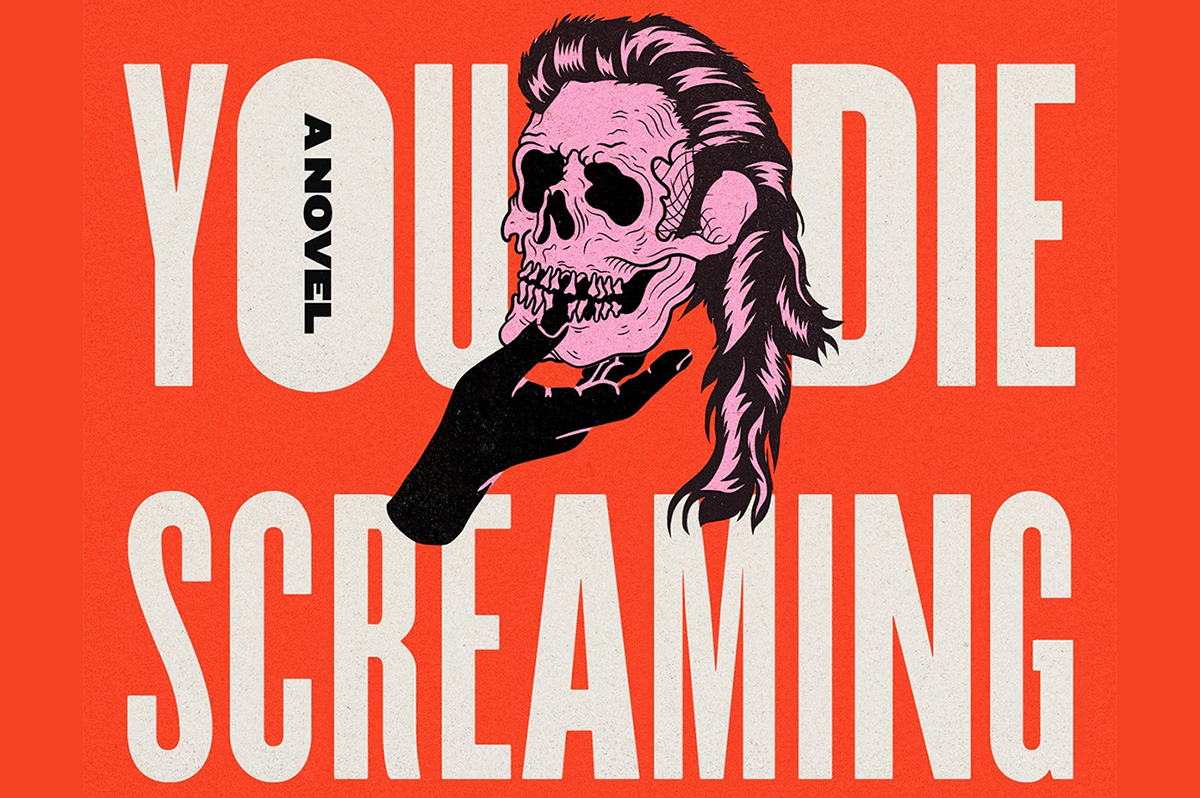
‘Make Sure You Die Screaming’
By Zee Carlstrom
c.2025, Random House
$28/304 pages
Sometimes, you just want to shut the door and forget what’s on the other side.
You could just wipe it from your memory, like it didn’t occur. Or create an alternate universe where bad things never happen to you and where, as in the new novel “Make Sure You Die Screaming” by Zee Carlstrom, you can pretend not to care.

Their mother called them “Holden,” but they’d stopped using that name and they hadn’t decided what to use now. What do you call an alcoholic, queer, pessimistic former ad executive who’s also “The World’s First Honest White Man,” although they no longer identify as a man? It’s a conundrum that they’ll have to figure out soon because a cop’s been following them almost since they left Chicago with Yivi, their psychic new best friend.
Until yesterday, they’d been sleeping on a futon in some lady’s basement, drinking whatever Yivi mixed, and trying not to think about Jenny. They killed Jenny, they’re sure of it. And that’s one reason why it’s prudent to freak out about the cop.
The other reason is that the car they’re driving was stolen from their ex-boyfriend who probably doesn’t know it’s gone yet.
This road trip wasn’t exactly well-planned. Their mother called, saying they were needed in Arkansas to find their father, who’d gone missing so, against their better judgment, they packed as much alcohol as Yivi could find and headed south. Their dad had always been unique, a cruel man, abusive, intractable; he suffered from PTSD, and probably another half-dozen acronyms, the doctors were never sure. They didn’t want to find him, but their mother called…
It was probably for the best; Yivi claimed that a drug dealer was chasing her, and leaving Chicago seemed like a good thing.
They wanted a drink more than anything. Except maybe not more than they wanted to escape thoughts of their old life, of Jenny and her death. And the more miles that passed, the closer they came to the end of the road.
If you think there’s a real possibility that “Make Sure You Die Screaming” might run off the rails a time or three, you’re right. It’s really out there, but not always in a bad way. Reading it, in fact, is like squatting down in a wet, stinky alley just after the trash collector has come: it’s filthy, dank, and profanity-filled. Then again, it’s also absurd and dark and philosophical, highly enjoyable but also satisfying and a little disturbing; Palahniuk-like but less metaphoric.
That’s a stew that works and author Zee Carlstrom stirs it well, with characters who are sardonic and witty while fighting the feeling that they’re unredeemable losers – which they’re not, and that becomes obvious.
You’ll see that all the way to one of the weirdest endings ever.
Readers who can withstand this book’s utter confusion by remembering that chaos is half the point will enjoy taking the road trip inside “Make Sure You Die Screaming.”
Just buckle up tight. Then shut the door, and read.
The Blade may receive commissions from qualifying purchases made via this post.
Books
Two new books on dining out LGBTQ-style
Visit nightclubs, hamburger joints, and a bathhouse that feeds customers
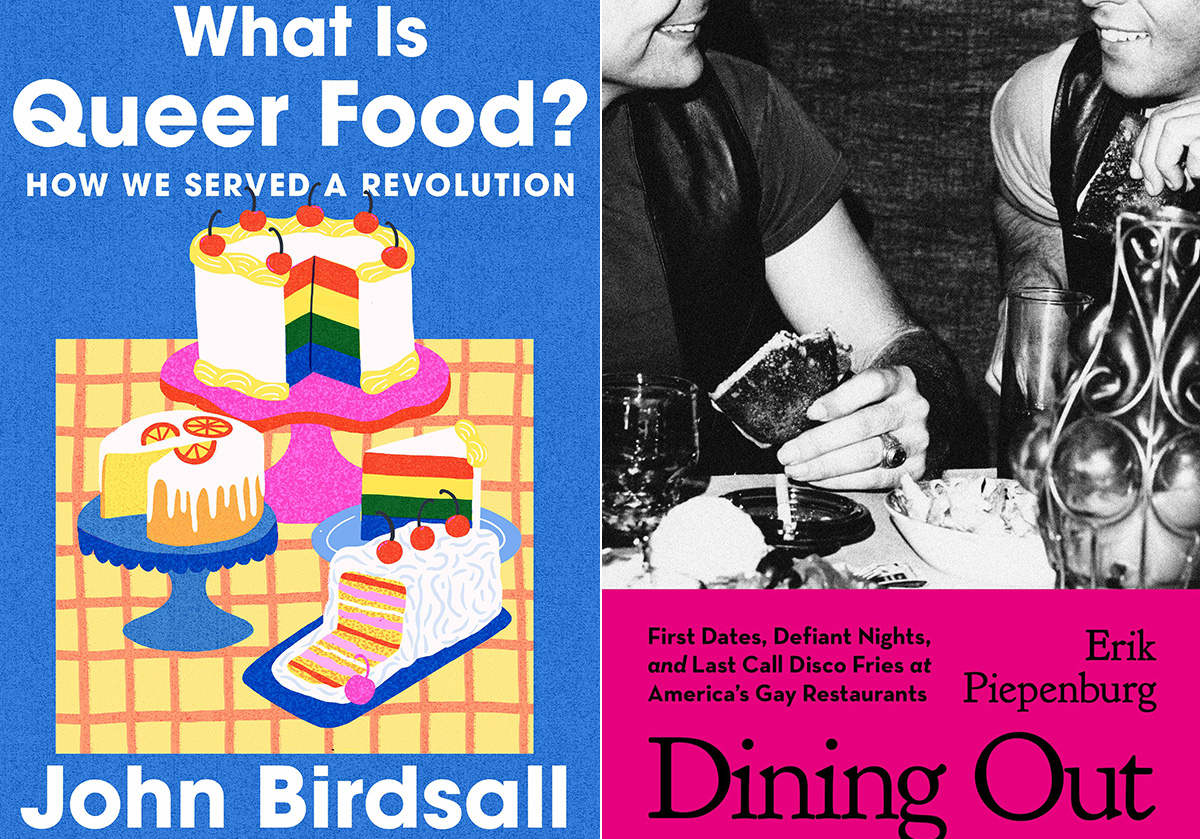
‘What is Queer Food? How We Served a Revolution’
By John Birdsall
c.2025, W.W. Norton
$29.99/304 pages
‘Dining Out: First Dates, Defiant Nights, and Last Call Disco Fries at America’s Gay Restaurants’
By Erik Piepenburg
c.2025, Grand Central
$30/352 pages
You thought a long time about who sits where.
Compatibility is key for a good dinner party, so place cards were the first consideration; you have at least one left-hander on your guest list, and you figured his comfort into your seating chart. You want the conversation to flow, which is music to your ears. And you did a good job but, as you’ll see with these two great books on dining LGBTQ-style, it’s sometimes not who sits where, but whose recipes were used.
When you first pick up “What is Queer Food?” by John Birdsall, you might miss the subtitle: “How We Served a Revolution.” It’s that second part that’s important.

Starting with a basic gay and lesbian history of America, Birdsall shows how influential and (in)famous 20th century queer folk set aside the cruelty and discrimination they received, in order to live their lives. They couldn’t speak about those things, he says, but they “sat down together” and they ate.
That suggested “a queer common purpose,” says Birdsall. “This is how who we are, dahling, This is how we feed our own. This is how we stay alive.”
Readers who love to cook, bake or entertain, collect cookbooks, or use a fork will want this book. Its stories are nicely served, they’re addicting, and they may send you in search of cookbooks you didn’t know existed.
Sometimes, though, you don’t want to be stuck in the kitchen, you want someone else to bring the grub. “Dining Out” by Erik Piepenburg is an often-nostalgic, lively look at LGBTQ-friendly places to grab a meal – both now and in the past.

In his introduction, Piepenburg admits that he’s a journalist, “not a historian or an academic,” which colors this book, but not negatively. Indeed, his journeys to “gay restaurants” – even his generous and wide-ranging definitions of the term – happily influence how he presents his narrative about eateries and other establishments that have fed protesters, nourished budding romances, and offered audacious inclusion.
Here, there are modern tales of drag lunches and lesbian-friendly automats that offered “cheap food” nearly a century ago. You’ll visit nightclubs, hamburger joints, and a bathhouse that feeds customers on holidays. Stepping back, you’ll read about AIDS activism at gay-friendly establishments, and mostly gay neighborhood watering holes. Go underground at a basement bar; keep tripping and meet proprietors, managers, customers and performers. Then take a peek into the future, as Piepenburg sees it.
The locales profiled in “Dining Out” may surprise you because of where they can be found; some of the hot-spots practically beg for a road trip.
After reading this book, you’ll feel welcome at any of them.
If these books don’t shed enough light on queer food, then head to your favorite bookstore or library and ask for help finding more. The booksellers and librarians there will put cookbooks and history books directly in your hands, and they’ll help you find more on the history and culture of the food you eat. Grab them and you’ll agree, they’re pretty tasty reads.
The Blade may receive commissions from qualifying purchases made via this post.
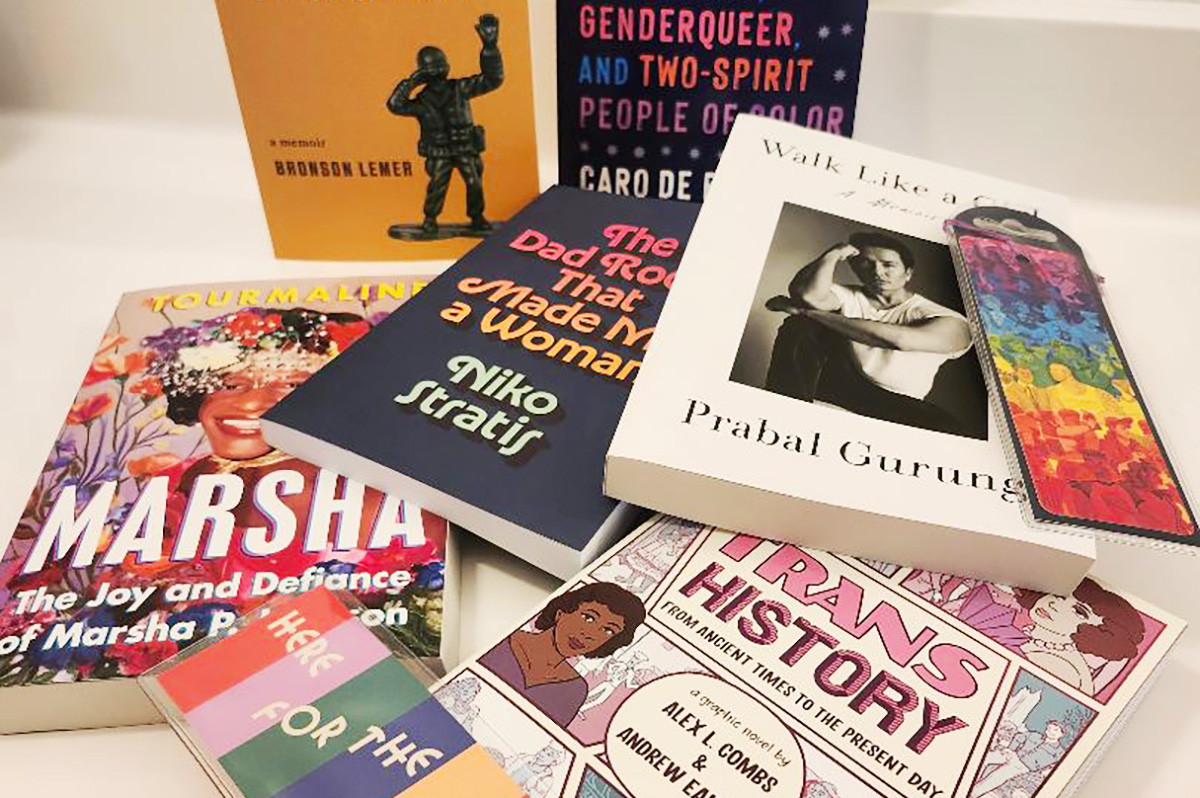
You’re going to be on your feet a lot this month.
Marching in parades, dancing in the streets, standing up for people in your community. But you’re also likely to have some time to rest and reflect – and with these great new books, to read.
First, dip into a biography with “Marsha: The Joy and Defiance of Marsha P. Johnson” by Tourmaline (Tiny Rep Books, $30), a nice look at an icon who, rumor has it, threw the brick that started a revolution. It’s a lively tale about Marsha P. Johnson, her life, her activism before Stonewall and afterward. Reading this interesting and highly researched history is a great way to spend some time during Pride month.
For the reader who can’t live without music, try “The Dad Rock That Made Me a Woman” by Niko Stratis (University of Texas Press, $27.95), the story of being trans, searching for your place in the world, and finding it in a certain comfortable genre of music. Also look for “The Lonely Veteran’s Guide to Companionship” by Bronson Lemer (University of Wisconsin Press, $19.95), a collection of essays that make up a memoir of this and that, of being queer, basic training, teaching overseas, influential books, and life.
If you still have room for one more memoir, try “Walk Like a Girl” by Prabal Gurung (Viking, $32.00). It’s the story of one queer boy’s childhood in India and Nepal, and the intolerance he experienced as a child, which caused him to dream of New York and the life he imagined there. As you can imagine, dreams and reality collided but nonetheless, Gurung stayed, persevered, and eventually became an award-winning fashion designer, highly sought by fashion icons and lovers of haute couture. This is an inspiring tale that you shouldn’t miss.
No Pride celebration is complete without a history book or two.
In “Trans History: From Ancient Times to the Present Day” by Alex L. Combs & Andrew Eakett ($24.99, Candlewick Press), you’ll see that being trans is something that’s as old as humanity. One nice part about this book: it’s in graphic novel form, so it’s lighter to read but still informative. Lastly, try “So Many Stars: An Oral History of Trans, Nonbinary, Genderqueer, and Two-Spirit People of Color” by Caro De Robertis (Algonquin Books of Chapel Hill. $32.00) a collection of thoughts, observations, and truths from over a dozen people who share their stories. As an “oral history,” you’ll be glad to know that each page is full of mini-segments you can dip into anywhere, read from cover to cover, double-back and read again. It’s that kind of book.
And if these six books aren’t enough, if they don’t quite fit what you crave now, be sure to ask your favorite bookseller or librarian for help. There are literally tens of thousands of books that are perfect for Pride month and beyond. They’ll be able to determine what you’re looking for, and they’ll put it directly in your hands. So stand up. March. And then sit and read.
-

 Federal Government2 days ago
Federal Government2 days agoTreasury Department has a gay secretary but LGBTQ staff are under siege
-
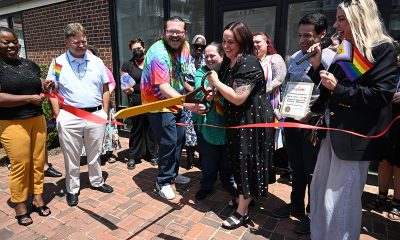
 Virginia3 days ago
Virginia3 days agoDefying trends, new LGBTQ center opens in rural Winchester, Va.
-

 District of Columbia2 days ago
District of Columbia2 days agoGay GOP group hosts Ernst, 3 House members — all of whom oppose Equality Act
-
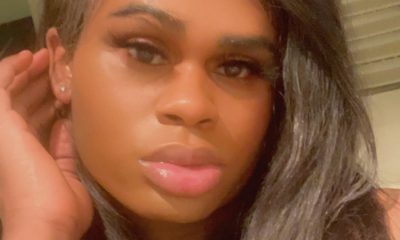
 District of Columbia2 days ago
District of Columbia2 days agoD.C. police seek public’s help in July 5 murder of trans woman

